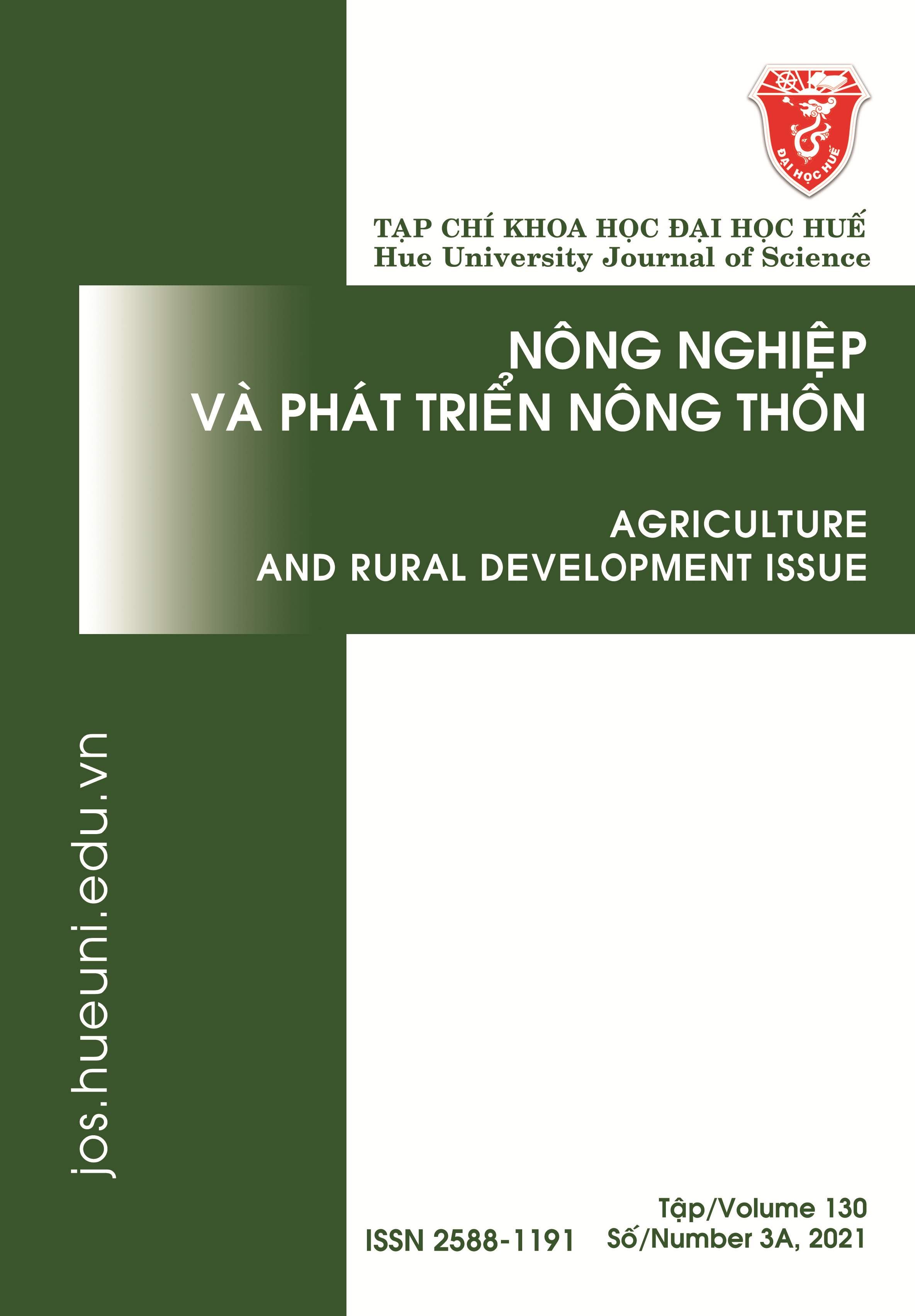Abstract
Studying herbicide resistance in Vietnam is limited, and there are very few reports on the regrowth of weed after applying herbicides. A survey to investigate the cultivating habit and the barnyard grass regrowing in the direct-seeded rice fields after applying herbicides in Thua Thien Hue shows that the main labourers of rice cultivation are male with a low educational level to understand scientific and technical knowledge. The most common grass regrowing in direct-seeded rice fields after applying herbicides includes Barnyard grass (Echinochloa crus-galli), Grass-like fimbry (Fimbristylis miliacea), Bermuda grass (Cynodon dactylon), and Sprangletop (Leptochloa chinensis). The yield decreases from 12.1 to 14.0% because of regrowing of barnyard grass. The herbicides commonly used in Thua Thien Hue are Sofic 300EC (Pretilachlor) and Sunrice 15WDG (Ethoxysulfuron), but their effectiveness has decreased in recent time owing to farmers’ inappropriate spraying skills and the decrease in the effectiveness of herbicides. A more thorough assessment of the factors that cause grass regrowing after spraying herbicides is required for better weed management.
References
- Baltazar A. M. (2017), Herbicide-resistant weeds in the Philippines: Status and resistance mechanisms, Weed Biology and Management 17, 57–67.
- Bhullar G. S. (2015), Sustainable Rice Production, In: Lichtfouse E., Goyal A. (eds) Sustainable Agriculture Reviews, 16: 107-121, Cham. https://doi.org/10.1007/978-3-319-16988-0_5.
- Brar D., Khush G. (2013), Biotechnological approaches for increasing productivity and sustainability of rice production, In: Bhullar G., Bhullar N. (eds) Agricultural sustainability – progress and prospects in crop research, Elsevier Inc., San Diego, CA, USA, 152–176.
- Chin D. V. (2001), Biology and management of barnyardgrass, red sprangletop and weedy rice, Weed Biology and Management 1, 37–41.
- Chin D. V., Thi H. L. (2010), Fifty years of weed research in rice in Vietnam, Agriculture Publishing House, Hanoi, Vietnam.
- Holm L. G., Plucknett D. L., Pancho J. V., Herberger J. P. (1977), The world’s worst weeds: Distribution and biology, University Press of Hawaii, Honolulu, USA.
- Juraimi A. S., Uddin M. K., Anwar M. P., Mohamed M. T. M., Ismail M. R., Man A. (2013), Sustainable weed management in direct seeded rice culture: a review, Australian Journal of Crop Science 7, 989–1002.
- Le D., Chon N. M., Mann R. K., Kumar B. V. N., Morell M. A. (2018a), Efficacy of RinskorTM (florpyrauxifen-benzyl ester) on herbicide resistant barnyardgrass (Echinochloa crus-galli) in rice fields of Mekong delta, Vietnam, Journal of Crop Science and Biotechnology, 21, 75–81.
- Le D., Nguyen C. M., Mann R. K., Yerkes C. N., Kumar B. V. N. (2017), Genetic diversity and herbicide resistance of 15 Echinochloa crus-galli populations to quinclorac in Mekong Delta of Vietnam and Arkansas of United States, Journal of Plant Biotechnology, 44, 472–477.
- Le D., Nguyen C. M. N., Kumar B. V. K., Mann R. K. (2018b), Weed management practices to control herbicide-resistant Echinochloa crus-galli in rice in Mekong Delta, Vietnam, Research on Crops 19, 20–27.
- Khaliq A., Chauhan B. S., Sparks D. L. (2015), Chapter five - Weeds of direct-seeded rice in Asia: Problems and opportunities, Advances in Agronomy, 130, Academic Press, 291–336.
- Matloob A., Khaliq A., Chauhan B. S., Sparks D. L. (2015), Chapter five - Weeds of direct-seeded rice in Asia: Problems and opportunities. In., Advances in Agronomy, Academic Press, (130) 291–336.
- Nguyễn Hồng Sơn (2000), Một số nghiên cứu về cỏ dại trên ruộng lúa cấy và biện pháp phòng trừ ở Đồng bằng Sông Hồng, Luận án Tiến sĩ, Trường Đại học Nông Nghiệp I, Hà Nội.
- Nguyễn Hữu Hoài (2001), Nghiên cứu cỏ dại trên lúa gieo thẳng ở Quảng Bình và một số biện pháp phòng trừ, Luận án Tiến sĩ, Trường Đại học Nông nghiệp I, Hà Nội.
- Nguyễn Thị Trường, Lương Minh Tâm, Nguyễn Vĩnh Trường (2017), Điều tra hiện trạng gây hại của cỏ dại trên lúa gieo sạ và phòng trừ ở Quảng Nam, Tạp chí Bảo vệ thực vật, 270, 22–29.
- Nguyễn Vĩnh Trường, Trần Ngọc Sỹ, Nguyễn Văn Lâm (2017), Điều tra tình hình phòng trừ cỏ dại hại lúa và khảo nghiệm các loại thuốc trừ cỏ ở Bình Định, Tạp chí Khoa học Đại học Huế - Nông nghiệp và Phát triển Nông thôn, 126,183–194.
- Nguyễn Vĩnh Trường, Võ Khánh Ngọc (2018), Điều tra tình hình gây hại và biện pháp quản lý cỏ dại lúa ở Quảng Trị, Tạp chí Khoa học Công nghệ Nông nghiệp, 2, 589–598.
- Oerke E. C. (2006), Crop losses to pests, The Journal of Agriculture Science, 144, 31–43.
- Phùng Đăng Chinh, Dương Hữu Tuyền, Lê Trường (1978), Cỏ dại và biện pháp phòng trừ, Nxb. Nông nghiệp, Hà Nội.
- Rao A. N., Ladha J. K. (2013), Economic weed management approaches for rice in Asia, In: Bakar BH, Tjitrosoedirdjo S (eds), Proceeding 24th Asian-Pacific Weed Science Society Conference, October 22–25, 2013, Bandung, Indonesia, Asian-Pacific Weed Science Society and Weed Science Society Indonesia Bandung, Indonesia.
- Rodenburg J., Johnson D. E., Sparks D. L. (2009), Chapter 4 - Weed management in rice - Based cropping systems in Africa, Advances in Agronomy, 103, Academic Press, 149–218.
- Rouse C. E., Roma-Burgos N., Norsworthy J. K., Tseng T. M., Starkey C. E., Scott R. C. (2017), Echinochloa resistance to herbicides continues to increase in Arkansas rice fields, Weed Technology, 32, 34–4.
- Ruzmi R., Ahmad-Hamdani M. S., Bakar B. B. (2017), Prevalence of herbicide-resistant weed species in Malaysian rice fields: A review, Weed Biology and Management, 17, 3–16.
- Zimdahl R. L. (2007), Fundenmetal of weed science, Academic Press, New York.
